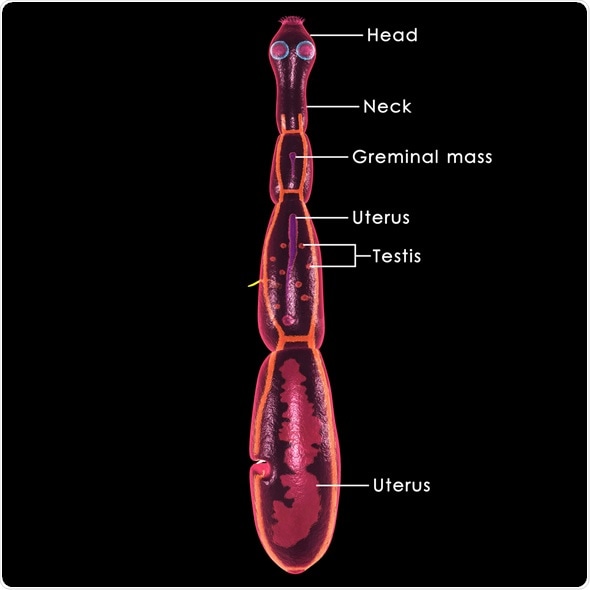Echinococcosis is a term used to describe a potentially lethal zoonotic disease caused by tapeworms of the genus Echinococcus.
Disease states can be further sub-classified into either cystic echinococcosis (caused by Echinococcus granulosus) or alveolar echnicoccosis (caused by Echinococcus multilocularis), depending on the infecting organism.

Echinococcus granulosus - Image Copyright: sciencepics / Shutterstock
Echinococcus multilocularis is found around the world in many arctic and temperate areas of the northern hemisphere.
The life cycle of this parasite is principally sylvatic and dependent on carnivorous species such as the wolf, fox, and coyote. Small mammals and rodents act as the intermediate hosts for this parasitic species.
Human infections are the result of accidental ingestion of infective eggs excreted in the feces of aforementioned definitive animal hosts; therefore humans are also considered intermediate or accidental hosts.
Since the life cycle involves wild animals as both definitive and intermediate hosts, adequate prevention and control of this disease is quite complex.
Disease Presentation
Albeit alveolar echinococcosis is an uncommon disease, its presentation can be very serious, leading to a case fatality rate of 50% or greater in symptomatic cases.
In addition, many infections with Echinococcus multilocularis are diagnosed late, which increases the risk of a serious or fatal outcome.
This type of echinococcosis most often starts with an asymptomatic incubation period that can last up to fifteen years, during which time a tumor-like lesion slowly develops in the liver.
Potential clinical signs include abdominal pain, enlarged liver, general feeling of malaise, weight loss, jaundice, and hepatic failure.
Sometimes, the parasite can disseminate through the blood and lymphatic system to other distant locations (most notably to the lungs or the brain).
Conversely, the primary cyst can die early in its development, and the disease can thus remain completely asymptomatic.
Diagnostic Findings
Alveolar echinococcosis usually becomes symptomatic in advanced age, when it mimics hepatic malignancy or cirrhosis.
Plain radiography can show enlargement of the liver and scattered zones of radiolucency that are outlined by calcific rings from 2 to 4 mm in diameter.
Characteristic tomographic findings in alveolar echinococcosis are multilocular or single cystic lesions with partially calcified walls that are poorly demarcated from the surrounding tissue and that show irregular and variable thickness.
Peripheral calcification and perilesional edema are also typically observed.
In most individuals with alveolar echinococcosis, parasite-specific immunoglobulins that belong to all isotypes can be measured at diagnosis, and an association with hyperglobulinemia has also been reported.
Echinococcus species can be further distinguished by polymerase chain reaction, followed by sequencing or restriction fragment length polymorphism analysis.
Treatment and Prevention
A disperse and complex multilocular nature of infection makes treatment quite difficult once symptoms appear.
No parasiticide is currently available, thus only radical surgery of the liver lesion (when possible) offers a definitive cure, even though long-term treatment with albendazole or mebendazole may inhibit growth of larvae and reduce metastases.
Liver transplantation can also be a successful approach in otherwise terminal cases.
It is quite difficult to completely prevent exposure to Echinococcus multilocularis eggs from wild animals; nevertheless, food safety precautions combined with adequate hygiene can be helpful.
All fruits and vegetables (particularly those picked in the wild) should be washed thoroughly to remove any eggs.
Furthermore, fences can be placed around vegetable gardens to keep wild animals away.
Further Reading